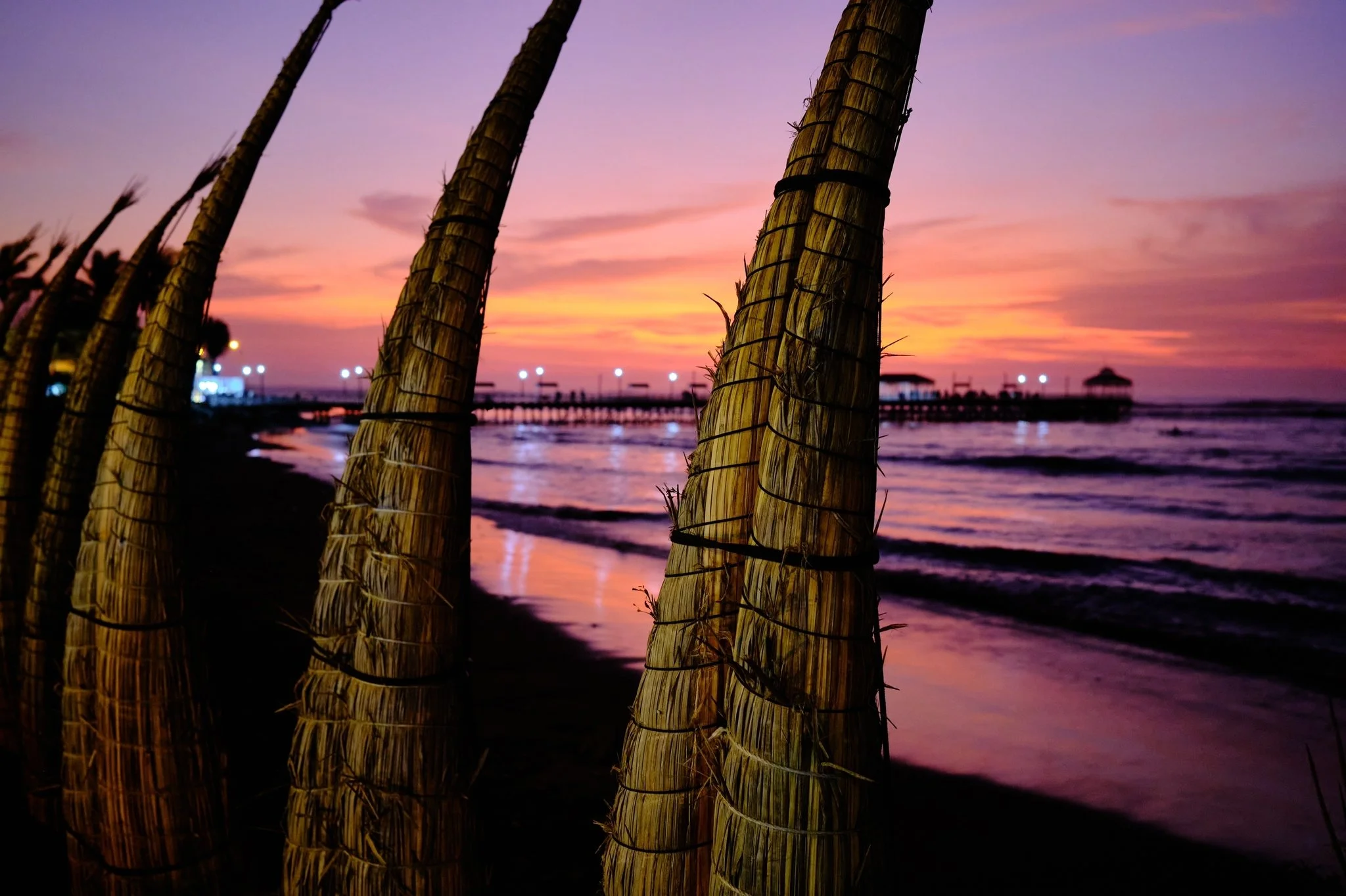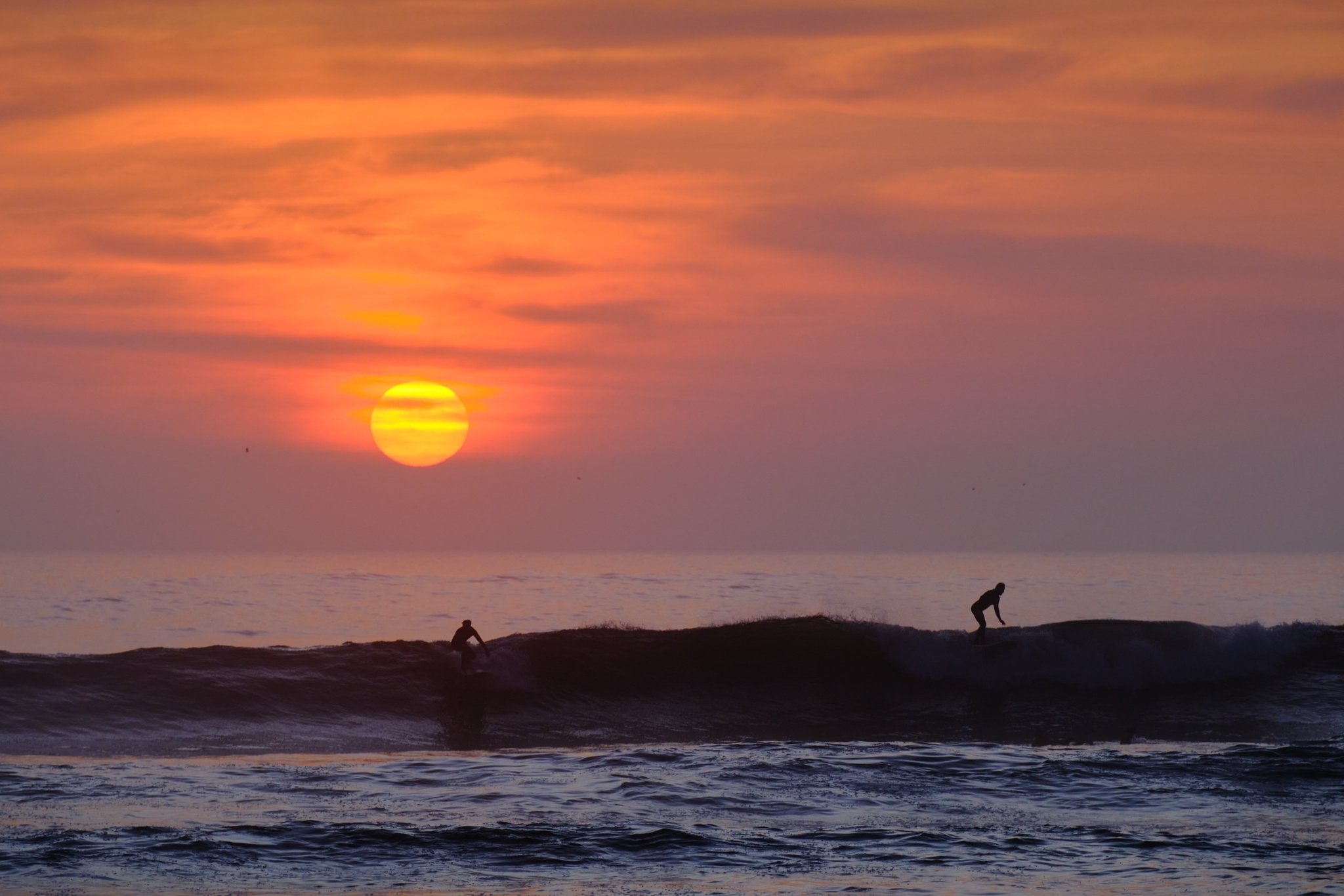WORDS & PHOTOS BY JOHN PELTIER
EDITED BY PHOTOGRAPHERS WITHOUT BORDERS
The northern coast of Peru has a long, proud heritage of life with the sea. Just outside of Trujillo one can explore Chan Chan, the largest pre-Columbian adobe city in South America. The 600 year old mud walls are adorned with reliefs of fish, waves, pelicans and sea otters. And in Huanchaco, modern fishermen still utilize reed fishing boats called caballitos de totora, a design that has not changed for 3,500 years, and are the oldest known craft used for “surfing.” Life with the sea was important then and still is today.
The reed watercraft lining Huanchaco's beaches are known as "caballitos de tortora", or "little reed horses". They have been Huanchaco's identity and way of life for thousands of years.
While Huanchaco’s fishermen still ride their caballitos every morning, fishing is no longer the biggest economic driver of the region – it’s tourism. Huanchaco’s beaches are a popular summer destination for Peruvians, particularly those from Trujillo, Peru’s third-largest city. Huanchaco is also world-renowned for its surfing, as the longest left-hand break in the world is just a few miles north. Huanchaco was designated as Latin America’s first World Surfing Reserve in 2013.
One of Swim Tayka's advanced swimmers beginning laps. She has been in these swim classes for five years now and has hopes of becoming a competitive swimmer one day.
Tourism – and the money generated by it – is important to the local governments that benefit. But go to the outskirts of Huanchaco’s developed tourist areas and you’ll find several communities largely populated by migrants from the highlands, many of whom were displaced by climate change and natural disasters, and political instability.
Few of these communities have running water or sewage systems, and there is only sporadic electricity. Many children are forced to work instead of continuing their education in order to boost family finances, and there are no community-based facilities for learning and developing new skills in a safe environment.
Otra Cosa Network (OCN) is a grassroots volunteer organization that began collaborating with residents of these communities in September 2004 and registered as an official charity in 2007. OCN concentrates programs in various areas – including environment, literacy, youth development and sports, women’s projects and education.
SWIMMING LESSONS & ENVIRONMENTAL EDUCATION
An Otra Cosa Network volunteer attempts a "proof of concept" for the new community hydroponics garden. When installed the following week, the garden will be used to provide nutrition for the community and a recurring source of income to sustain and expand the garden through sales at the market.
For an area with such strong, ancient ties to life with the ocean, children in the migrant communities around Huanchaco do not have any opportunities for water safety or swimming classes. The World Health Organization (WHO) released a report in 2019 citing drowning as the third-leading cause of unintentional injury death in the world. Children aged 1-14 years from low-income areas, particularly in the Pacific, make up the majority of these harrowing statistics. The latest numbers released by WHO report 1,178 drownings in Peru in 2018.
Three-quarters of all flood deaths are from drowning, and Huanchaco has seen some of the worst floodings in history in recent years due to intensified El Niño events.
SwimTayka is a global NGO that provides free swimming lessons and drowning prevention courses to children from disadvantaged communities living near open waters. In partnership with OCN, SwimTayka operates swim classes for communities in Huanchaco during the summer break, from the beginning of January to the end of February. These morning classes consist of roughly 60 children and 8-10 volunteer instructors.
Taking the surf lesson's youngest students on an introductory wave ride.
Luis, a ten-year-old swim student in his second month of lessons, says that the lessons aren’t just important because he wants to learn how to surf, but because they could also save his life – or someone else’s – one day.
That’s why Eduardo, one of the local instructors, volunteers to teach. “The lessons don’t just give children access to water; their heritage: They give them the gift of being able to save someone else’s life, too.” Eduardo notes that the goal is not to make students competitive swimmers – though a few of them are on that path. The goal is to give them the confidence and skills to safely be around water. His approach is to first get children comfortable in the pool with the use of kickboards and noodles to learn kicking and breathing skills. Then they bring it all together by swimming laps unassisted. Eduardo’s favorite part of teaching these lessons is seeing the dramatic progress they make in such a short period of time.
After the classroom lessons, all of the children are gathered in the courtyard for a question-and-answer session to ensure they understand the material presented.
In tandem with swimming skills, the instructors lead discussions about environmental education, including topics like clean water stewardship, climate change, the effects of pollution and environmental conservation. There’s also organized beach cleanups with kids and adults in the communities.
GIRLS & WOMEN’S EMPOWERMENT
One of the most popular programs run by OCN are the girls “LitClubs.” The single-sex clubs are led by instructors from the community who act as positive role models, aiming to create a safe space where children can discuss issues important to them and to encourage self-empowerment and education. Currently, there are 150 girls and young women participating in LitClubs.
A recent LitClub session for girls covered the topics of friendship and discrimination, and integrated confidence-building exercises.Teacher Yacquelin and teaching assistant Ruth facilitated the discussion by asking the girls how they would feel if someone teased them or told them they couldn’t do something because of their differences, which led to an in-depth conversation about all the ways and reasons people discriminate. The teachers also included lessons about the history of Africans in Peru and racism in the United States, highlighting important Afro-Peruanos and Black Americans like Rosa Parks and George Floyd. The participants were then asked to define racism in their workbooks, followed by a creative activity around the topic.
Ruth began participating in the LitClub when she was 12 and became a mentor when she turned 18. “When I’m with the girls, being able to teach them important words, answering their questions, starting conversations, and being able to pass on knowledge. I want them to be able to stand up for themselves until we live in a world where they no longer have to,” she says.
Visit the Otra Cosa to learn more about their work and offer support for their ongoing projects and programmes.









